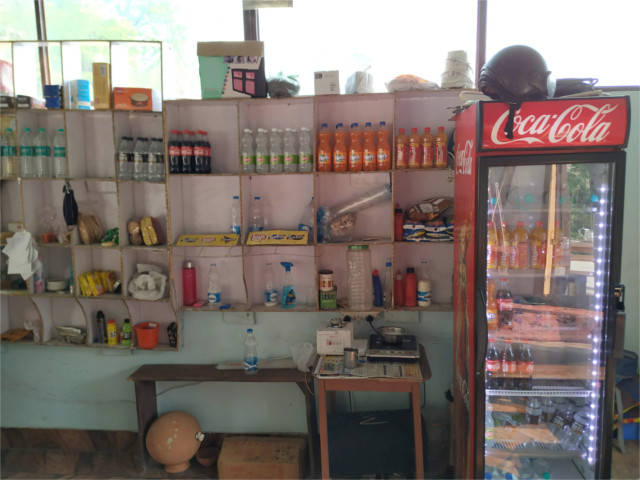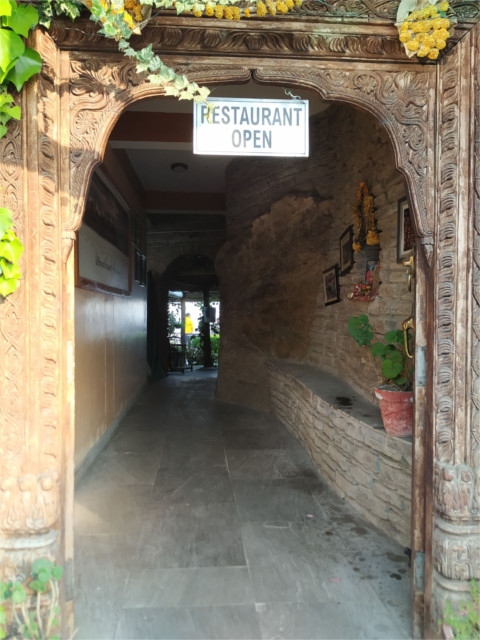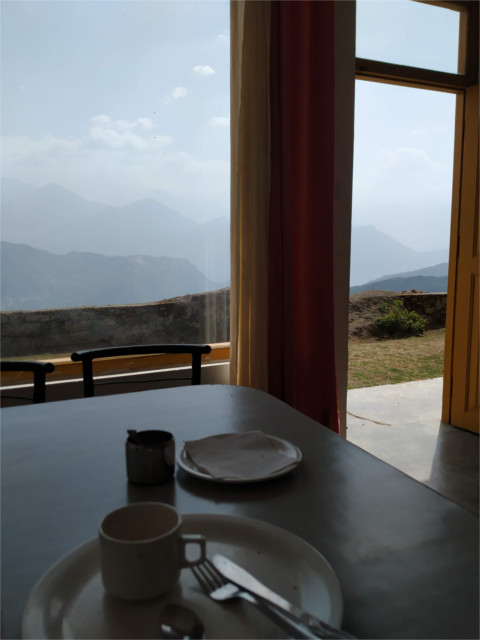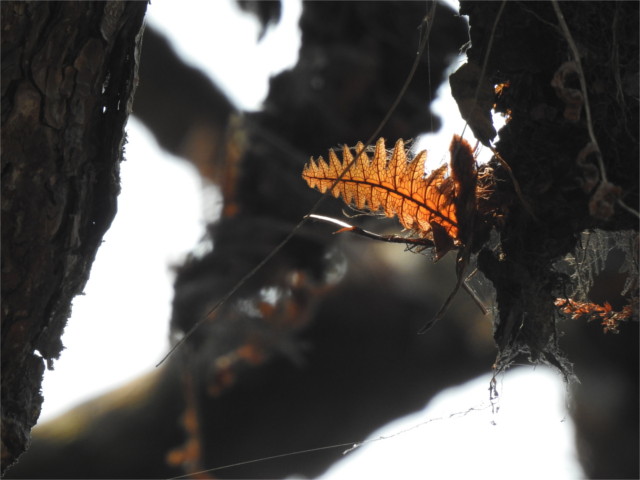Bal Mithai is a Kumaoni specialty, supposedly invented a century ago in Almora. It is exactly the kind of thing an ordinary halvai would dream up with ingredients at hand. Cut browned khoya into cubes, roll them in the little balls of sugar that are a second common ingredient in a sweet maker’s kitchen, and you are ready. The recipe is so simple that it has taken over the hills. Since the smoke of forest fires prevented us from taking walks, I’d decided not to have much in the way of sweets. But passing through a small town through a road lined with halvai’s shops I stopped the car momentarily and bought a hundred grams of these sweets. They are as toe-curlingly sweet as I remembered them to be. But a halvai’s tray full of them is a nice subject for a photo.
Tag: Almora
Looking for chai on the road
On road trips I’ve got used to stopping at road-side shacks for a tea now and then. The trip to Kumaon last month was the first time I found this to be difficult. As we travelled north of Almora, traffic thinned out and the little shacks by the road where you can normally stop for a chai or an omelette were hardly visible.
We peered with fading hope at little stores. Some had fresh food, but all had the shiny packets of trans-fats loaded with either salt or high-fructose corn syrup (sometimes both), liberally doused in sulfite containing preservatives, which are consumed in large quantities by travellers, after which the non-biodegradable packaging is dumped into the hillside. All of them also stocked highly sugared drinks in large plastic containers, which leak bisphenols into your body, and into the environment, when the empties are dumped out of cars. Very seldom did we find a place with a working kitchen. This was very specific to this part of Kumaon; closer to the lakes one could find the normal density of roadside eateries. Nor was it the mountain-hugging roads which made such shops difficult; even inside the small towns and villages we passed, a chai or a fresh snack was not so easy to find.
Our best finds were always close to a town. Outside Almora, on the Binsar road we found a wonderful bakery and cafe. Little terraces with potted plants overlooked a valley. Someone recommended the almond butter cake; we added a pie because the waiter told us it had just been baked. Both were superb with the steaming cups of tea they gave us. Uttarakhand has begun to produce an interesting variety of cheeses, and I selected a few from the counter to eat over the next few days.
Eventually, the most relaxed place that I found for chai was the dining area of our hotel in Munsiyari. The cook had a way with the chai and omelettes, and the pleasantly chatty waiter knew when to leave you alone with the view. The window looked over the town at the nearby Panchachauli massif. Even though the air was not clear enough for the wonderful views which gives Munsiyari its reputation as a place to visit, the place was wonderfully relaxed.
Parakeet morning
The tuneful but loud whistles of a Himalayan whistling-thrush woke me on my last morning in Almora. It was sitting in the balcony. The sun had not yet risen. I lay in bed enjoying the beautiful song of the bird. It used to be called the truant schoolboy once for its joyful whistling. The Family was in deep sleep, but I found that I was fully awake. I slipped on a jacket, and stepped into the balcony with my camera. The thrush was still whistling on a tree nearby. A great barbet called from far away, and in front of me plum-headed parakeets (Psittacula cyanocephala) wheeled in the sky, with their cheerful pinging calls.
I don’t see these birds very often. The male has a dark red-purple and the female a blue-grey head. The darker collar of the male and its red shoulder patch, the yellow neck of the female, the bright yellow upper beak, and the long blue tail with a yellow tip are other things to look for. The light was still fairly bad, but I took some photos anyway. They might not be there later. Taking photos disciplines my attention. I might not have caught the courtship feeding otherwise.
Since males and females are so easy to tell apart, even a casual observer like me can see a certain organization in the pack. First, the packs are mixed, but the sexes generally segregate when they come to rest. I wondered whether this is generally true, or even true of other species of parakeets. Unfortunately, I couldn’t find many studies of the social organization of parakeet flocks. The only paper I found was almost a century old and had studied pecking order in a different species of parakeets. The observations showed a lack of strict pecking hierarchy. It would be strange if no one is studying parakeet societies. When I look out of the window, they seem to be as intelligent and social as crows.
Altitude
We took an hour’s walk inside Binsar National Park, a short climb to its highest point. This Zero Point, as it is called is at an altitude of just over 2400 meters. The cool air at this height smelt clean, with a flavour of green trees. The view at the top showed smoky valleys, and the high Himalayas were almost invisible because of the haze. But just around this part of the park the winds and the cool heights had together managed to confine the smoke below. I’m sure that the air here is usually much cleaner, but at that time it still felt better than city air. The walk through an oak forest was wonderful, and a great change from sitting inside a car all day. At this height you get Himalayan white oak (Quercus leucotrichophora), easily identified by the fact that the oval leaves with serrated edges are white on the reverse. The dry tree fern that you see in the featured photo is just one of many things which grow on oaks.
Coming back to our hotel, we felt the change in the air. Warmer, of course, now that we were half a kilometer lower, and also more haze. Fortunately there was no smell of smoke in the immediate vicinity. We were told that a short shower the previous day had put out fires locally, and cleared the haze a little. I admired a red sunset as I walked up the steep forested path from the road to the hotel. Pollution gives you interesting sunsets.
Rhododendron heights
This is meant to be extremely literal: red rhododendron (Rhododendron arboreum) in its native Himalayas grows at altitudes between 1500 and 2500 meters. This means that almost all of Kumaon is at the right altitude for this lovely blood red flower. Micro-climates can cause upward or downward fluctuations in this band. Human effort also brings it down to gardens at somewhat lower altitudes in India, but not to the plains. Climate change can also cause upward migration of the tree, but as as tourist you would not be able to disentangle the effect of micro-climate and global warming.
After several years, we’d come back to a hotel outside Almora which has a large area of jungle around it. We woke late, did a little birdwatching right from the balcony of our room. When we walked down for breakfast I was surprised to find no flowers on the rhododendron. Just a month before we’d been to a similar height and the rhodos had not started flowering. Early April is smack in the middle of the season. “Monkeys,” explained the person we asked. “They come and eat the flowers.” I found one flower which they had missed. That’s the one you see in the featured photo.
Bhimtal to Binsar
Bhimtal during the day did not look nearly as romantic as it did during the sunset. We left it behind and took the road to Bhowali, where we wanted to join up with the main Nainital-Ranikhet road. Not having researched Bhowali, we did not know that it has a “beautiful fruit market which offers to the tourists [a] rich variety of fruits” as a tourism website puts it.
We stopped just before the crowded junction of the Bhimtal-Bhowali and Nainital-Ranikhet roads, just out of the zone where traffic policemen were enforcing a no-parking rule. On one side of the road was a little stream which had become a sewer, but the other side was lined with shops selling a staggering variety of fruits and nuts. We stocked up on many things which we recognized, and one (see the photo above) which we did not. It was mildly astringent, and could have been unripe. Can anyone help with this? What is it called?
A couple of hours on we found that one side of the road dropped away into a reasonably broad river valley. The river itself was running pretty dry in October, when we visited, and the banks were full of tumbled rocks. The hillsides had mixed forests. So this was bound to have great diversity of birds. Unfortunately there was no way down to the river. We stopped for lunch after crossing a high bridge and passing the confluence of two rivers (see the photo above). Lunch was delicious and fresh: rotis hot from the oven served with pungent onions, a simple but delicious moong dal with lots of local greens thrown into it, and a chutney which incorporated some other local herbs. Of the four or so tables in the tiny dhaba two had tourists carrying long lenses, and the others seemed to be full of Kumaonis.
There was no network, so we could not figure out which river we stood by. Later we found that the river was not even marked in Google Maps, although switching to a satellite view does show the river bed. We figured from the infrequent signage that this was either the Kosi river (and clearly not the flood-prone Kosi which runs through Bihar) or a tributary. Interestingly, this Kosi does not figure in Wikipedia either.
After lunch we loitered for a while trying to spot birds. This is the kind of landscape where we would expect to see the brilliant blue-green plumage of Verditer Flycatchers. We scanned the trees and rocks. No sign of flycatchers, nor of redstarts. By now we had left the mixed forests behind and were inside pine forests, and I suspected that this was the reason we found no birds.
The chir pines are local, but were first systematically cultivated across the region by the British. Even now economics continues to dictate the spread of pine forests in Kumaon. One problem with this is that pine forests reduce the diversity of species growing within them. As an example, there are very few pests of pines, which is good for those who cultivate it, but which also means that there is little for birds to feed on. As a result, birders and butterfly or moth enthusiasts would do well to avoid these. Some villages have begun to make efforts to repair this destruction of habitats by replacing pine forests with more productive forests anchored by the local varieties of oak.
We drove for a large part of the afternoon and reached Almora in good daylight. We did not need to go into the town, but we did. After taking a long drive through Almora we came back to the Almora-Binsar road and continued on to our hotel. We completed our check-in as the sunlight turned to liquid gold. Our rooms faced Nanda Devi, but there was too much haze to see the peak clearly. What we saw was a Verditer Flycatcher! There was also a Great Barbet sitting in a tree near the balcony. Our tea arrived as we soaked in the atmosphere.
The sun set as we finished our tea. Before the light faded from the sky we decided to take a little walk in the woods around the hotel. During this walk we spotted an uncharacteristically quiet Himalayan whistling thrush, and a chattering Himalayan bulbul. A grey-backed shrike posed for us on a little post next to the road. Then, just as the light was about to fade completely, a fluttering in the bushes caught my attention. There was a jewel, a day-flying burnet moth, the Campolytes histrionicus. The bad light forced me to use an image enhancement setting on my camera which blurs the photo a bit. But it was a good end to the day.
Urban sprawl
We decided to go live outside Almora for a week last diwali. Childhood stories had primed me to expect long walks along forested hills. Even though I knew that things would have changed since, the reality was like being hit on the nose by a fish. Almora sprawls across a horse-shoe shaped mountain wall: all the way from the crest to the bottom, and laps up several lower hills in the surrounded valley. It can be picturesque from a little further away at sunrise (above) and sunset (below). The district is beautiful, and we had a lovely holiday living in a hotel 10 kilometers further down the highway towards Binsar.

On diwali night our driver insisted on filling up the tank, and we drove around until he found a satisfactory petrol pump. We walked on to see the lit up town of Almora sprawled in front of us. As I took photos, a family running a shop nearby invited us to their balcony for the view. It was lovely, and became even more charming when the man pointed out that the humps on the ridge look like a dinosaur’s back. Indeed they do.
From Srinagar in the west to Dambuk in the east, the hills are alive with the sound of construction. But the mess is full of friendly people living out their lives like you and me.






















